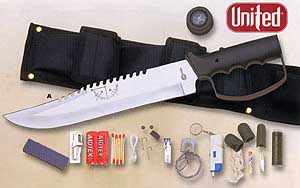Featured Member Video
How to stabilize scales, the easy way.More Videos by Camp10
View larger or ask the author a question.
View all wilderness survival videos
Recent Forum Posts 
| Thread Title | Replies |
| commercial manager salary uk | 2 |
| проститутки кантем... | 0 |
| SAD that this forum........DIED. | 8 |
| best | 0 |
| .......... | 2 |
| weather | 0 |
| AR Pistol Notice | 18 |
| What "ONE" Thing do you h... | 0 |
| "WAREAGLE" Wherefore art-... | 0 |
| Solar Eclipse April the 8th | 3 |
Come Join the Discussion Today!
Our site has been mentioned in:
U.S. News and World Report
Best of the Web - Site of the Week 8/6/01
Discovery Channel Canada
One Week in the Wilderness
USA Today
Hot Sites 08/08/2005
Fish Illness and Treatments
With plants, you need to watch for insects or mildew. In your fish tank, you are going to be on the look-out for diseases and even injuries. Thankfully, a closed system that doesn't have contact with "wild" fish is going to be fairly protected from many diseases. If you keep your tanks clean, you should have few problems.
Overcrowded tanks are more prone to diseases, and they will spread very quickly through the water from fish to fish once it starts. Keep a particularly close eye on your fish when you have a large tank of them to monitor.
Diseases like ich or fin rot are very common in fish tanks, and are the most likely problems you'll come across with your fish, regardless of the species. Ich looks like white spots growing all over the scales of your fish, and fin rot is exactly like it sounds. Both will develop in dirty water, so the best approach is to keep a clean tank in the first place.
A popular treatment for many health problems may seem strange to the novice, but a dose of salt to the water can actually cure many ills. A little salt can be quite toxic to the various fungi that might be in your tank, yet it's not enough to harm your fish. It has to be sea salt or salt intended for aquariums. Never use table salt. A standard recipe is to use 1/2 ounce of salt per gallon of fish tank volume, and add it slowly over the course of several days. It even helps with oxygen absorption and gill health.
Of course, it can effect your plants if you keep salt in your main tanks. Many plants will be fine with this low level of salinity though. If you choose to use salt on a regular basis (and many aquaponicists actually do this), get a salinity meter to monitor the levels. This type of salt treatment is the most common way of dealing with ich, by the way.
Many other potential problems are not diseases at all. Water quality can be behind several other fish illnesses. We talk a bit more about water later in this book, but it should be mentioned quickly here. Too much ammonia and nitrites will poison your fish, and too little oxygen will also make them sick to the point of death. If you see your fish gulping air at the surface, that is a sure problem sign. Remove some of the water and refresh the tanks. Add an extra aerator to boost up that oxygen content.
Treating fish for disease or parasites can be tricky because the chemicals end up in the water and that can lead to problems with your plants. For easier fish care, you might want to keep an extra tank handy to use as a hospital tank. As a separate tank that is not connected to your plant beds, you can treat the water with antibiotics or salt without worrying about the plants.
Ultimate Survival Knife & Kit |
List Price: 61.99 Our Price: 39.95 |
This 15 inch survival knife with drop point blade features a thick quality stainless steel blade with serrated top edge. Textured and ribbed solid metal handle and guard. Nylon sheath. Survival kit includes a hollow grip with a compass top to store items within the knife itself, as well as additional pouches on the sheath to hold the rest. Complete survival kit. Click Here to Buy the Survival Knife Now. |
|

